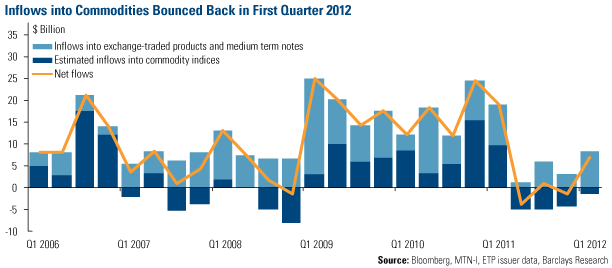Energy and Natural Resources Market Radar (April 23, 2012)

Strengths
- Following three months of extremely weak investor activity last year, investment flows into commodities rebounded in the first quarter of 2012 with $6.9 billion fresh inflows into the asset class. The first quarter was the strongest quarter for flows in a year, though still a long way below the first quarter of 2011 ($19 billion) and the average quarterly inflow over the past five years ($11 billion). As a result, total assets under management bounced back to $435 billion, an all-time high.
- China’s power consumption rose 7 percent year-over-year to 416 billion kilowatt hours (kWh) in March, accelerating 0.3 percentage points from the January-February period, the National Energy Administration (NEA) said this week. For the first quarter of this year, electricity consumption added only 6.8 percent from a year ago to 1.1655 trillion kWh, as shortened working days in January due to the Chinese Lunar New Year holidays cut industrial demand of energy, according to the NEA.
- Japan’s imports of liquefied natural gas (LNG) rose to a record last fiscal year as utilities turned to fossil fuels after the Fukushima nuclear disaster led to the shutdown of almost all the nation’s atomic reactors. Japan purchased 83.18 million metric tons of LNG from overseas in the fiscal year ended March, up 18 percent from the previous 12 months, the finance ministry said in a preliminary report this week. That’s the highest level since the government started collecting the data in 1980.
Weaknesses
- U.S. distillers are losing money on every gallon of ethanol they make after they cranked up production to meet government targets that ended up overshooting demand for the biofuel. The BGOV Barometer shows that producers are losing 7 cents a gallon, after breaking even as recently as December, as waning demand for gasoline dried up the market for ethanol to blend with the motor fuel. The U.S. government is raising its targets for ethanol use as gasoline demand is slumping. A 2007 law requires refiners to mix 13.2 billion gallons of renewable products with motor fuels in 2012, up 4.8 percent from last year. Gasoline demand averaged over four weeks fell 4.9 percent from a year earlier, according to U.S. Energy Department data. “Too much ethanol is chasing too little a market,” said Wallace Tyner, an agricultural economist at Purdue University.
- North American aluminum mill orders in March showed the largest year-over-year decline in new orders since November 2009, according to data released by the Aluminum Association. Total orders less domestic can stock were down 2.2 percent year-over-year in March, and the declines were noted across a number of semis markets, with plate and electrical conductor products seeing the largest fall, down 10 percent and 41 percent, respectively. March data was a dark patch in an otherwise bright quarter for North American orders, which were up 8.8 percent year-over-year in the first quarter.
Opportunities
- In an analysis by Macquarie Capital, Vale reported that its average mined grade of iron ore declined from 56.6 percent in 2010 to 55.5 percent in 2011. In mining terms this is a large fall and reinforces our view that ore degradation is as large a problem in iron ore as in any other commodity and will contribute to sustaining high capital levels and increased need for large Chinese domestic ore volumes in the market for longer than expected.
- Soybean purchases by China, the world’s biggest importer, will be “clearly higher” than the U.S. Department of Agriculture’s estimate of 55 million metric tons because of improved crushing margins, said the China National Grain and Oils Information Centre. The country may ship in 13.8 million tons from July to September, after importing 4.7 million tons in April, 5.8 million tons in May and 5.5 million tons in June, it said. The increase may drain global stockpiles already reduced by lower production in Brazil and Argentina after drought parched crops, and bolster futures in Chicago that have risen 18 percent this year. Imports by China have more than doubled in the past seven years as rising incomes and increasing urbanization have spurred demand for meat, poultry and dairy.
- In LNG markets, the Federal Energy Regulatory Commission gave Cheniere Energy approval to begin construction on the Sabine Pass LNG liquefaction project in Texas, which is a brownfield project based on the existing regasification terminal.
- Jiangxi Copper Co Ltd., China's top copper producer, said high inventories in China are a temporary issue and will gradually come down, although end users remain cautious and some expect lower prices and are keeping inventories low. Chairman Li Yihuang said he was not worried about slower economic growth in China and forecast copper prices will average $8,500 a ton in 2012 before moving higher in the next few years.
Threat
- This week, Argentina's government effectively initiated a process to nationalize oil company YPF, thereby ousting Repsol as majority 57 percent shareholder and expropriating a 51 percent stake. Unease in the sector is expected to continue while details of any compensation have yet to be confirmed.













